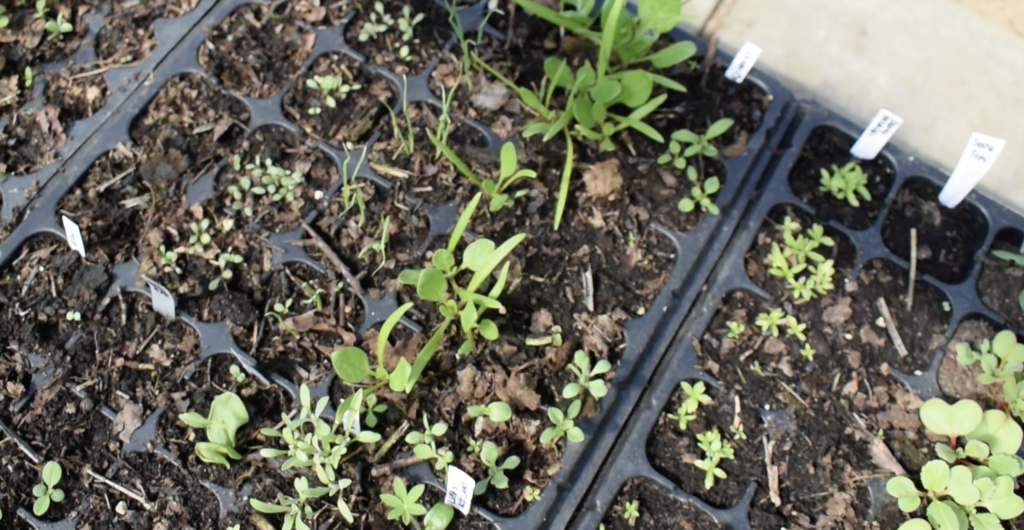What Is Winter Sowing?
Winter sowing is a gardening technique that involves sowing seeds outdoors during winter, typically in containers like milk jugs, in the greenhouse, or even directly in the snow. The seeds are exposed to natural winter conditions, including cold temperatures and fluctuating weather, which helps them naturally stratify and break dormancy.
The exposure to outdoor conditions during winter helps seedlings develop resilience and adaptability to changing weather. This process is similar to the hardening-off phase of indoor-sown seedlings before transplanting.
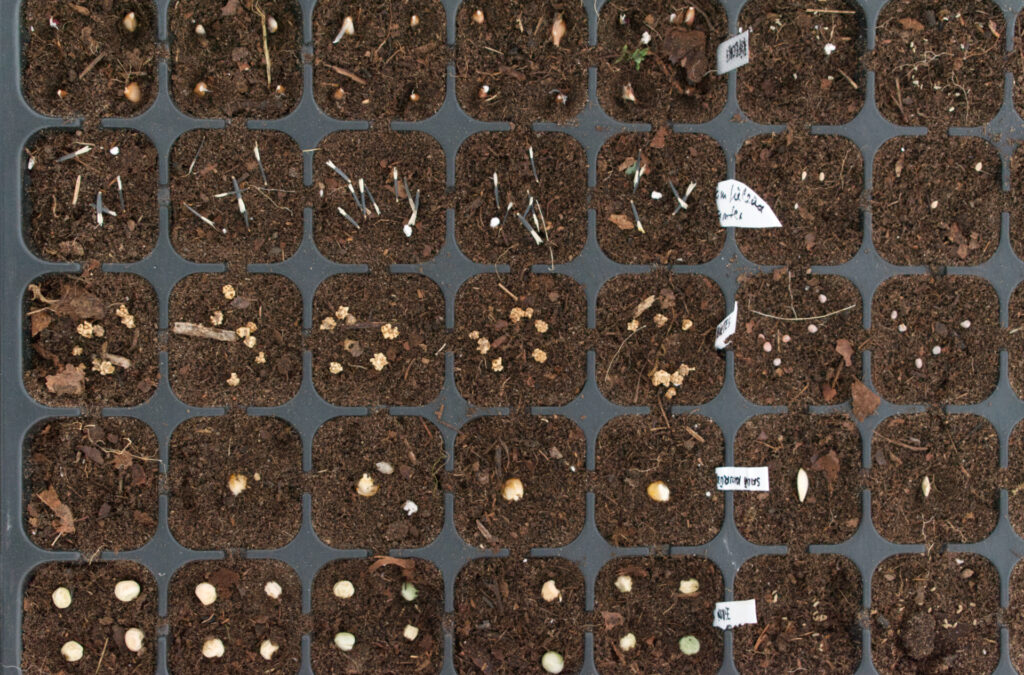
Benefits of Winter Sowing
- Low Cost: Winter sowing eliminates the need for indoor setups like grow lights and heating pads, reducing the overall cost of starting seeds.
- Natural Timing: Seeds sown in winter naturally germinate at the right time for their specific climate and growing zone. This helps plants sync with the local growing season.
- Hardier Plants: Seedlings grown through winter sowing tend to be hardier and better adapted to outdoor conditions due to exposure to the fluctuating winter weather.
- Increased Seed Variety: Winter sowing allows for experimenting with a wider variety of plants, including those that might be challenging to start indoors.
- Less Maintenance: Once seeds are sown, winter sowing requires minimal maintenance compared to indoor seed starting. If you choose to sow in containers, they act as mini-greenhouses, protecting the seeds.
Disadvantage
- You will need to sow more seeds than usual because not all seeds will “survive” this harsh process.
When should I start winter sowing?
The best time to sow in zone 5 is December to March, depending on the weather conditions in your area. I sowed seeds at the end of February.
Sowing Process and Techniques
Before I tried my green thumbs on winter sowing, I researched other blogs and resources on what to sow in growing zone 5. Some of the named vegetables were Kale, Spinach, Leafy Greens, Broccoli, and flower seeds like Coneflower, Delphinium, and Lupine. However, I still needed clarity about some seeds, so I did a little experiment in my greenhouse.
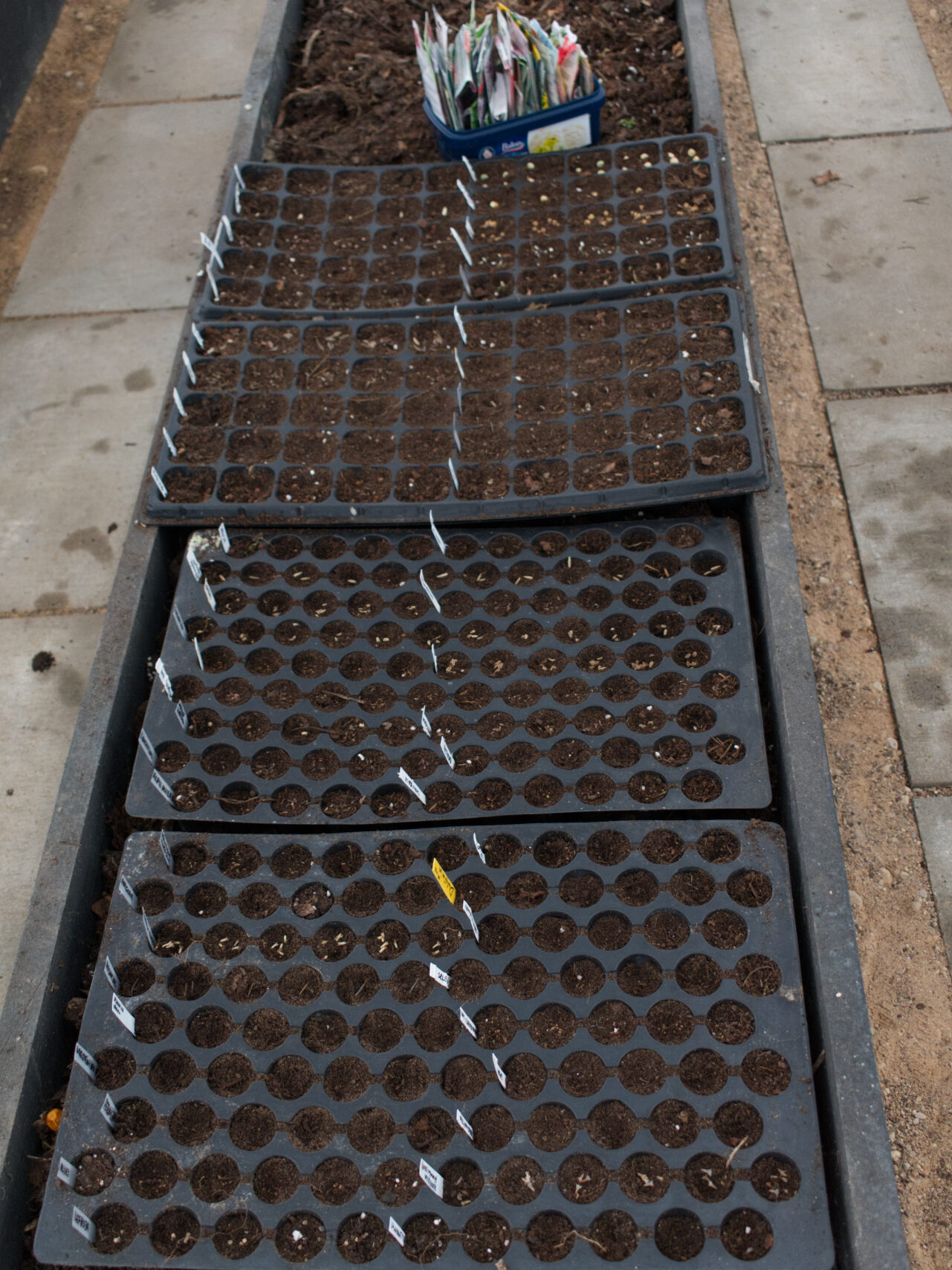
On February 25th, I started my experiment by gathering all the seeds that I wanted to experiment with, and I came up with 57 different seeds in total (some seeds I got some days later). Next, I placed seed trays and filled them with soil from the greenhouse. This was actually my first mistake because that soil also contained weeds. When something sprouted from seeds I hadn’t sowed before, I wasn’t 100% sure if it was really the plant or just a weed. I chose to use seed trays for their portability in case if I needed to move them somewhere else, and they also looked more tidy than just sowing in jugs or straight in the soil. I sowed and labeled each row on seed trays, sprinkled with more soil, and then covered with the snow. During the day, the greenhouse would warm up, melting the snow, but at night, it would freeze. More or less, the environment was similar to the outside world. We even got really chilly weather after some days of sowing -20C (-4F) on the 9th of March.
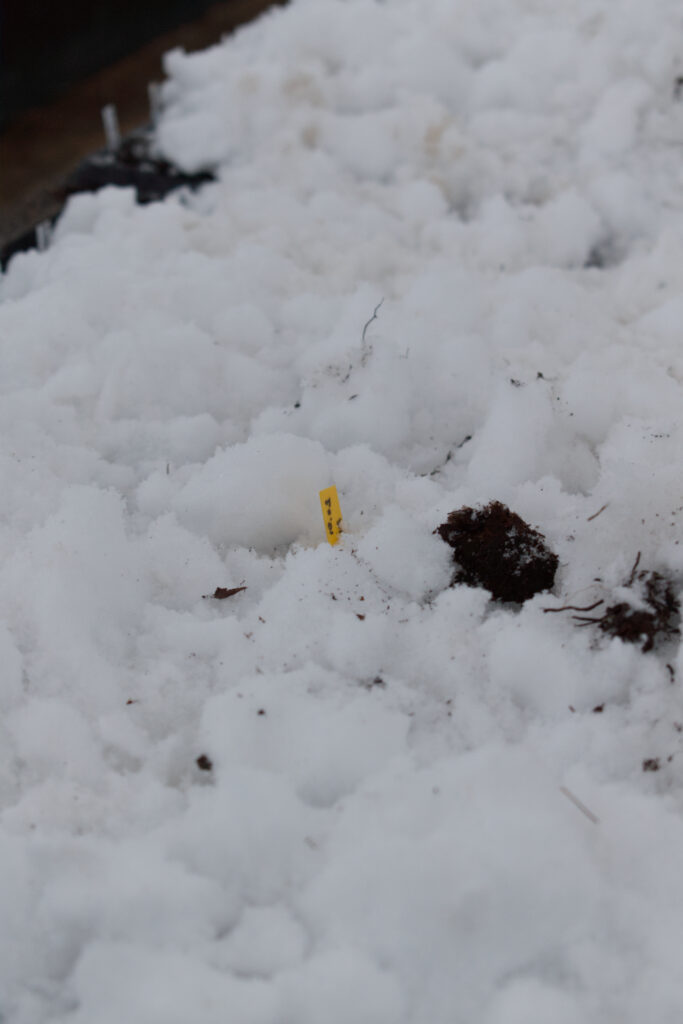
Here is the list of all sowed seeds:
| Flowers | Vegetables |
| Marigold | Peas |
| Achillea Ptarmica | Carrots |
| Sunflowers | Sweet corn |
| Blazing Star | Zucchini |
| Rudbeckia | Beetroot |
| Hollyhocks | Radish |
| Sweetpeas | Tomatoes |
| Salvia | Onions |
| Echinops Ritro | Iceberg lettuce |
| Aster Balloon | Cauliflower |
| Echinacea | Dill |
| Pansy | Parsley |
| Verbena Bonariensis | Basil |
| Malva Sylvestris | Kale |
| Limonium | Broccoli |
| Alpine Aster | Brussels Sprouts |
| Dusty Miller | Cabbage |
| Poppies | Celery |
| Cornflower | Garlic |
| Cosmos | Rocket Greens |
| Amaranth | Spinach |
| Veronica Spicata | |
| Obedient Plant | |
| Catmint | |
| Petunia | |
| Armeria Maritima | |
| Alyssum | |
| Snapdragons | |
| Matthiola | |
| Calendula | |
| Lavender | |
| Wild carrot | |
| Sanguisorba Officinalis | |
| Lupin | |
| Zinnia | |
| Matthiola longipetala (Night-Scented Stock) |
Monitoring Growth and Progress
For monitoring, I created a Google Sheet where I registered the day of sowing, the first sprouting, the day of transplanting, and notes on how well the seedling was doing.
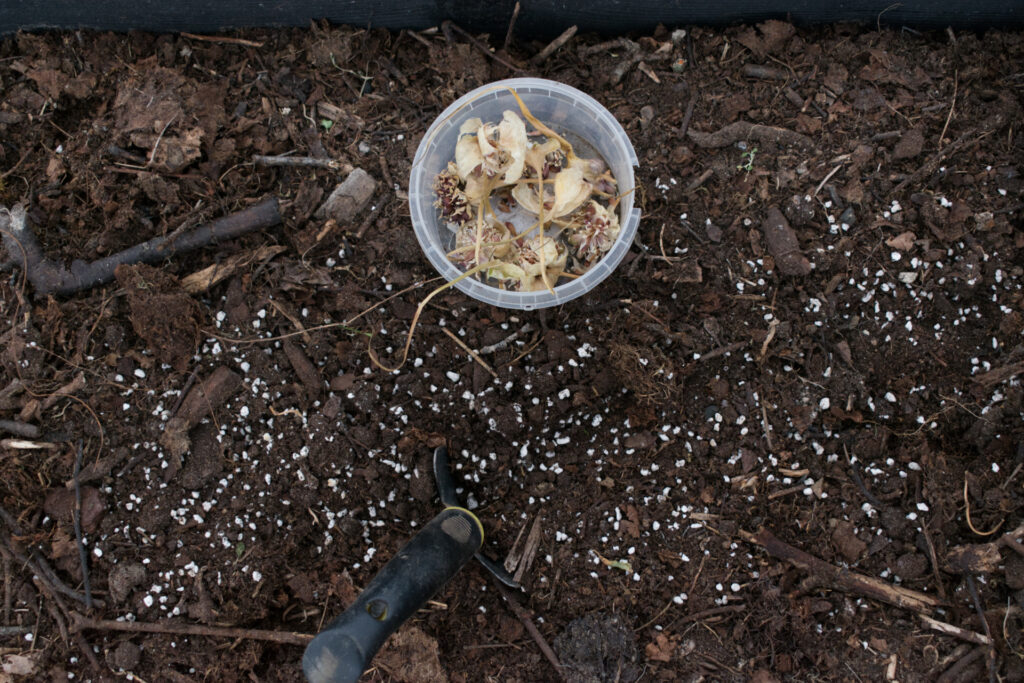
March
Only after a month did the sown seeds start to sprout. The first ones to show some root sprouting were Peas, but after frost, only one survived. From the 17th to the 19th of March, I saw sprouting Radishes, Spinach, Matthiola Longipetala (Night-Scented Stock), and Rocket Greens. From the 20th to 27th of March, seeds that sprouted were Kale, Garlic, Cornflower, Lupin, Achillea Ptarmica, Beetroot, Marigold, Zinnia, Hollyhocks, Iceberg Lettuce, Cauliflower, Aster Balloon, Broccoli, Alyssum, Matthiola, Sanguisorba Officinalis, and Cabbage.
Seeds that sprouted really well and became vigorous seedlings in March were Night-Scented Stock, Cornflower, and Garlic.
Zinnia, Hollyhocks, Iceberg Lettuce, Alyssum, and Sanguisorba officinalis were sprouting poorly from all the sowed seeds.
The rest of the seeds sprouted well or on average.
Also, on a sunny day, the greenhouse warmed to +25C (+68F).
April
From the 4th to the 8th of April, sprouted Onions, Poppies, Obedient Plants, Snapdragons, Carrots, Parsley, Catmint, and Pea. From the 11th to the 18th of April, Sprouted Rudbeckia, Sunflower, Echinops Ritro, Echinacea, Pansy, Verbena Bonariensis, Malva Sylvestris, Dusty Miller, Celery, Wild Carrot, Salvia, Tomatoes, and Veronica Spicata.
Seeds that sprouted really well and became vigorous seedlings in April were onions and echinacea.
Seeds that sprouted poorly from all the sowed seeds were Pea, Sunflower, Salvia, Echinops Ritro, Veronica Spicata, Obedient Plant, and Wild Carrots.
The rest of the seeds sprouted well or on average.
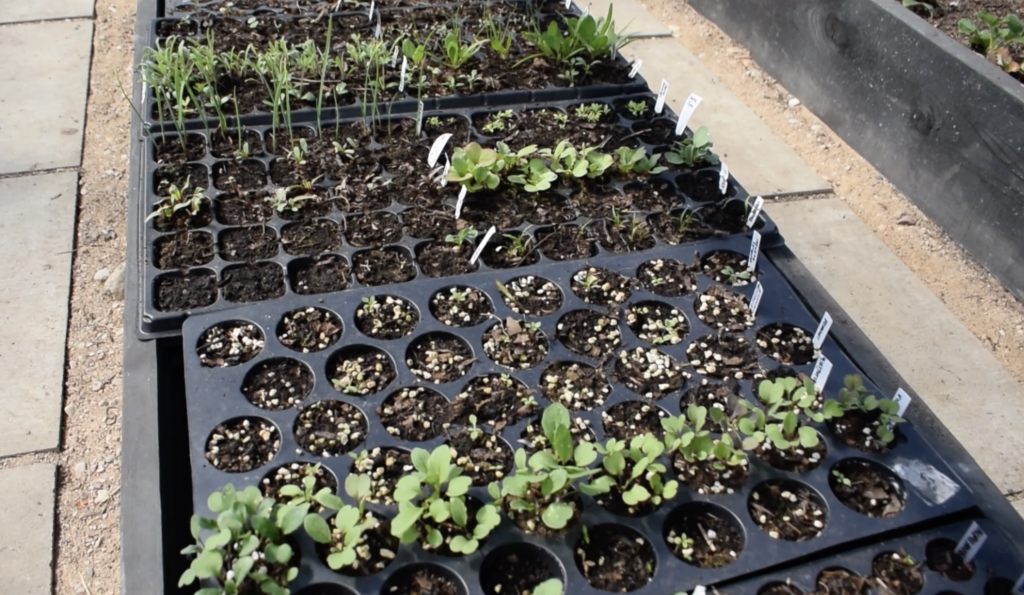
Seeds That Did Not Sprout At All
Seeds that didn’t sprout at all were Sweet Corn, Zucchini, Blazing Star Flowers, Sweet Peas, Dill, Basil, Limonium, Alpine Aster, Brussels Sprouts, Cosmos, Amaranth, Petunia, Armeria Maritima, Calendula, and Lavender.
The reason might been in the quality of the seeds or environment – cold and wet, which leads to rot.
Results And The Best Seeds For Winter Sowing
When picking seeds for this experiment, I already knew that some of them, for example, Sweet Corn and Zucchini, wouldn’t germinate in these harsh conditions. To my surprise, I thought the same about Tomato seeds, but they proved me wrong when spouted. I also thought the Pea would survive cold temperatures as it was often called a “hardly plant”.
Best Flower Seeds For Winter Sowing
In my opinion, flower seeds like Night-Scented Stock, Cornflower, and Echinacea benefited the most from winter sowing by showing vigorous growth. Other flower seeds that can be great for winter sowing are Marigolds, Achillea Ptarmica, Lupin, Rudbeckia, Aster Balloon, Poppies, Catmint, and Snapdragons.
Best Vegetable Seeds For Winter Sowing
From edible ones, it’s safe to winter sow Carrots, Radishes, Spinach, Kale, Rocket Greens, Beetroot, Onions, Garlic, and Parsley.
Conclusion
This experiment taught me that not all hardy seeds will sprout or grow well and that not all warm-loving seeds won’t sprout after exposure to negative temperatures.
I will definitely continue winter sowing, not only because it’s beneficial for some plants but also because it’s nice to see something sprouting while the rest of the garden is covered in snow. It also helps save space indoors.
Seeds that I will continue to winter sow will be more eatable things like Carrots, Radishes, Spinach, Kale, and Rocket Greens, but from flowers – Night-Scented Stock, Cornflower, and maybe Wild Carrots. I will sow the remaining seeds in the greenhouse in April when temperatures are milder.
